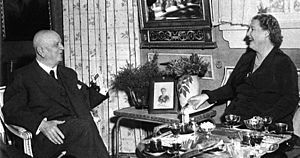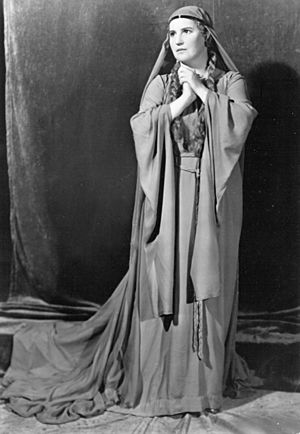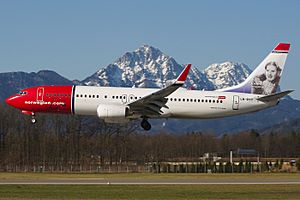Kirsten Flagstad facts for kids
Kirsten Malfrid Flagstad (born July 12, 1895 – died December 7, 1962) was a famous Norwegian opera singer. She was known as a fantastic Wagnerian soprano, which means she sang the main female roles in operas by Richard Wagner. Many people believe she was one of the greatest singers of the 1900s. Some even called her "the voice of the century" because her singing was so beautiful and strong.
Contents
Early Life and Musical Beginnings
Kirsten Flagstad was born in Hamar, Norway, at her grandparents' house. Even though she didn't live there, she always thought of Hamar as her hometown. She grew up in Oslo in a very musical family. Her father, Michael Flagstad, was a conductor (who leads an orchestra), and her mother, Maja Flagstad, was a pianist.
Kirsten started her music training in Oslo. She made her first stage appearance in 1913 at the National Theatre in Oslo. She sang the role of Nuri in an opera called Tiefland. She also made her first recordings around this time.
After studying more in Stockholm, Sweden, she started her career in opera and operetta (a lighter type of opera) in Norway. She was very good at learning new roles quickly, sometimes in just a few days! In 1919, she got married and had her only child, a daughter named Else Marie.
Singing in Sweden and New Roles
From 1928 to 1934, Kirsten sang at the Stora Teatern in Gothenburg, Sweden. She sang in many operas there, including Der Freischütz. In 1930, she married her second husband, Henry Johansen, who helped her career grow.
For over ten years, Kirsten sang lighter opera roles. But then she decided to try more dramatic parts, like those in Tosca and Aida. These roles helped her show off her powerful voice. In 1932, she sang the role of Isolde in Wagner's Tristan und Isolde. This was a big moment, as it seemed she had found the perfect type of music for her voice.
A Swedish singer named Ellen Gulbranson suggested Kirsten audition for the famous Bayreuth Festival in Germany, which is all about Wagner's operas. Kirsten sang smaller roles there in 1933. But in 1934, she sang bigger roles like Sieglinde in Die Walküre and Gutrune in Götterdämmerung.
Becoming a Star at the Metropolitan Opera
Kirsten Flagstad was first noticed by the Metropolitan Opera (Met) in New York City in 1929. The Met is one of the most famous opera houses in the world. In 1934, the Met needed a new singer, and Kirsten agreed to audition. She was hired right away!
Her first performance at the Met was on February 2, 1935, as Sieglinde in Die Walküre. It was a huge success! Even though she was not well-known in the United States at the time, her performance was broadcast on the radio across the country. The radio host, Geraldine Farrar, was so amazed that she announced a new star had been born.
Just days later, Kirsten sang Isolde, and soon after, she performed Brünnhilde in Die Walküre and Götterdämmerung. Before the season ended, she also sang in Lohengrin, Tannhäuser, and Parsifal. Almost overnight, she became the most important Wagnerian soprano of her time. Many people say her amazing voice even helped save the Metropolitan Opera from financial trouble because so many people bought tickets to see her.
Performances Around the World
Kirsten Flagstad performed a lot, sometimes three or four times a week. She also helped the Met by asking radio listeners for donations. In 1935, she sang all three Brünnhilde roles in the Ring cycle in San Francisco. In 1937, she also performed in Chicago.
In 1936 and 1937, she sang at the Royal Opera House, Covent Garden, in London, where she was just as popular as in New York. She also toured Australia in 1938. Hollywood even tried to get her to appear in movies because she was so famous. She performed at the Hollywood Bowl and filmed a scene for a movie called The Big Broadcast of 1938. Kirsten Flagstad and figure skater Sonja Henie are the only two Norwegians with stars on the Hollywood Walk of Fame.
During her time at the Met, Kirsten worked with her vocal coach, Hermann Weigert, who helped her prepare for all her roles. She also helped her accompanist, Edwin McArthur, become a conductor at the Met.
Returning to Norway During Wartime
In 1941, Kirsten's husband, who had returned to Norway, sent her urgent messages. She decided to leave the United States and go back to Norway, even though many friends advised her to stay. This was a difficult choice because Norway was occupied by German forces during World War II.
During the war, she only performed in Sweden and Switzerland, which were not occupied. However, her decision to return to Norway made her unpopular, especially in the United States. After the war, her husband was arrested for his business dealings during the occupation. This, along with her choice to stay in Norway, caused her a lot of personal and professional difficulty. Later, it was revealed that her husband had been arrested by the Gestapo (German secret police) during the war, and one of his sons had been part of the Norwegian resistance.
Later Career and Farewell Performances
After the war, Kirsten Flagstad was invited back to the Metropolitan Opera by its new manager, Rudolf Bing. He believed that "The greatest soprano of this century must sing in the world's greatest opera house." She also returned to Covent Garden in London. From 1948 to 1952, she sang her famous Wagnerian roles again. She toured South America and returned to San Francisco. Even in her 50s, she was still in amazing shape as Isolde, Brünnhilde, and Leonore.

Despite her successful return, Kirsten decided that the 1950–1951 season would be her last singing Wagner on stage. She had gained weight and developed an arthritic hip, which made the physically demanding roles difficult. Her final opera performance at the Met was on April 1, 1955. It was not a Wagner role, but the main part in Gluck's Alceste. Her very last opera appearance was as Dido in Dido and Aeneas in Oslo on June 5, 1953.
After the war, Kirsten Flagstad was also chosen to perform the world premiere of Richard Strauss's Four Last Songs. Strauss, a famous composer, wanted her to sing these new pieces. She chose Wilhelm Furtwängler to conduct, and they performed the songs in London in 1950. Even at almost 55 years old, her performance was highly praised.
After retiring from the stage, she continued to give concerts and make recordings. She recorded many songs by composers like Grieg and Sibelius. She even made some stereo recordings of Wagner's operas. In 1958, she sang the role of Fricka in Wagner's Das Rheingold. She also spent time helping young singers in Norway.
From about 1952 until her death ten years later, Kirsten's health slowly got worse. She was often in and out of hospitals. From 1958 to 1960, she was the first Director of the Norwegian National Opera. She gave many benefit concerts in Norway in her last years. She was diagnosed with bone marrow cancer in 1960 and passed away on December 7, 1962. She was buried in an unmarked grave in Oslo.
Legacy and Impact
The Kirsten Flagstad Museum in Hamar, Norway, has a collection of opera items, including her costumes. Her picture has appeared on the Norwegian 100 kroner bill and on the tail of Norwegian Air Shuttle airplanes.
Opera critic Harold C. Schonberg described her voice as "enormous, but did not sound enormous because it was never pushed." He said it had a "cool silvery quality." Kirsten Flagstad sang the role of Isolde 70 times at the Met between 1935 and 1941, making Tristan und Isolde one of the most popular operas in the Met's history.
Famous Recordings
Kirsten Flagstad made many recordings throughout her career. Her complete recording of Tristan und Isolde with conductor Furtwängler is considered one of the best opera recordings ever made. It shows her amazing singing as she got older. She also recorded many songs by Grieg and other composers, which show how beautiful her voice remained.
Her recordings from before World War II show her voice at its freshest and clearest. These include Wagner arias, Beethoven arias, and Grieg songs. She also recorded duets with Lauritz Melchior. Many live radio broadcasts from the Metropolitan Opera also exist, allowing people to hear her famous performances.
After World War II, she made more important studio recordings, including:
- Scenes from Wagner operas.
- The complete opera Tristan und Isolde with Furtwängler.
- Norwegian Songs.
- Her role as Fricka in the 1958 recording of Das Rheingold.
Even near the end of her life, Kirsten Flagstad continued to sing beautifully. She was highly respected by record companies and the public until the very end.
Images for kids
See also
 In Spanish: Kirsten Flagstad para niños
In Spanish: Kirsten Flagstad para niños





